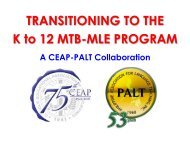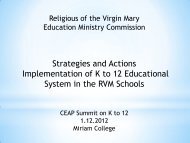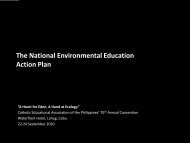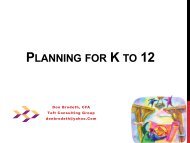Download - Catholic Educational Association of the Philippines
Download - Catholic Educational Association of the Philippines
Download - Catholic Educational Association of the Philippines
Create successful ePaper yourself
Turn your PDF publications into a flip-book with our unique Google optimized e-Paper software.
1<br />
SPIRAL PROGRESSION APPROACH<br />
TO TEACHING AND LEARNING<br />
Merle C. Tan, PhD<br />
Science Consultant & Convenor, K to 12<br />
National Institute or Science and Ma<strong>the</strong>matics<br />
Education Development, University <strong>of</strong> <strong>the</strong><br />
<strong>Philippines</strong>, Diliman, Quezon City<br />
merle.tan06@gmail.com
Flow <strong>of</strong> Presentation<br />
What is <strong>the</strong> spiral progression approach?<br />
Why spiral progression?<br />
What are <strong>the</strong> criteria for placing concepts in a<br />
particular grade?<br />
How is spiral progression applied in Science in <strong>the</strong><br />
K to 12?<br />
CEAP National Convention, 30 August<br />
2012<br />
2
What is <strong>the</strong> spiral<br />
progression<br />
approach?<br />
CEAP National Convention, 30 August<br />
2012<br />
3
Spiral Progression Approach<br />
Inspired by Bruner’s model <strong>of</strong> <strong>the</strong> spiral<br />
curriculum<br />
Students continually return to basic ideas as<br />
new subjects and concepts are added over <strong>the</strong><br />
course <strong>of</strong> a curriculum<br />
Done in order to solidify understanding over<br />
periodic intervals for students to learn, ra<strong>the</strong>r<br />
than simply memorizing equations to pass a<br />
test.<br />
CEAP National Convention, 30 August<br />
2012<br />
4
Revolves around <strong>the</strong> understanding that<br />
human cognition evolved in a step-by-step<br />
process <strong>of</strong> learning, which relied on<br />
environmental interaction and experience<br />
to form intuition and knowledge<br />
In simpler terms, one learns best through<br />
<strong>the</strong> repeated experience <strong>of</strong> a concept.<br />
Aligned with Bruner's <strong>the</strong>ory <strong>of</strong> discovery<br />
learning, which posits that students learn<br />
best by building on <strong>the</strong>ir current<br />
knowledge.<br />
CEAP National Convention, 30 August<br />
2012<br />
5
Spiral progression means developing <strong>the</strong> same<br />
concepts from one grade level to <strong>the</strong> next in<br />
increasing complexity and sophistication.<br />
Revisiting concepts at each grade level with<br />
increasing depth<br />
Building on pupils’ prior knowledge and<br />
skills … to allow gradual mastery from one<br />
grade level to <strong>the</strong> next<br />
Teaching general terms before specifics<br />
Guide to implementation: A carefully<br />
formulated scope and sequence<br />
CEAP National Convention, 30 August<br />
2012<br />
6
The spiral progression approach is applicable not<br />
only for science and math subjects (as <strong>of</strong>ten<br />
misunderstood) but for all subjects.<br />
The spiral progression approach is used from<br />
Grade 1 to Grade 10. This means that <strong>the</strong><br />
curriculum is not divided into elementary school<br />
and high school, <strong>the</strong> way it used to be. There is<br />
now “vertical articulation,” or a seamless<br />
progression <strong>of</strong> competencies.<br />
The seamlessness may actually be up to <strong>the</strong><br />
university curriculum.<br />
CEAP National Convention, 30 August<br />
2012<br />
7
Why Spiral<br />
Progression?<br />
CEAP National Convention, 30 August<br />
2012<br />
8
1. High drop out rate (based on DepEd Report Card)<br />
CEAP National Convention, 30 August<br />
2012<br />
9
Avoids <strong>the</strong> major disjunctions between stages <strong>of</strong><br />
schooling; provides <strong>the</strong> basis for continuity and<br />
consistency; Compartmentalization inhibit transfer <strong>of</strong><br />
learning across topics; students who exit school early do<br />
not have <strong>the</strong> basic functioning skills across requisite<br />
areas <strong>of</strong> science (University <strong>of</strong> Melbourne, Curriculum<br />
Comparison Study, 2011)<br />
Allows learners to learn Science topics and skills<br />
appropriate to <strong>the</strong>ir developmental/cognitive stages;<br />
Shows <strong>the</strong> interrelatedness <strong>of</strong> Science topics with each<br />
o<strong>the</strong>r and <strong>the</strong>ir connections across topics;<br />
Streng<strong>the</strong>ns retention and mastery <strong>of</strong> topics and skills;<br />
Enables DepED to benchmark Filipino students with<br />
<strong>the</strong>ir counterparts in o<strong>the</strong>r countries.<br />
CEAP National Convention, 30 August<br />
2012<br />
10
Reduce overlapping and ‘jumping’ sequence<br />
<strong>of</strong> topics in different grade levels<br />
CEAP National Convention, 30 August<br />
2012<br />
11
Science curriculum framework <strong>of</strong> high<br />
performing countries* follow a spiral<br />
progression and integrated approach at least<br />
up to G9<br />
No need to wait for Y2, Y3 and Y4 to learn<br />
concepts and <strong>the</strong>ir applications in Biology,<br />
Chemistry & Physics, respectively.<br />
Many topics in HS 1-4 are for college bound;<br />
Discipline based does not enable students to<br />
explore boundaries and connections across<br />
disciplines.<br />
* Australia, Brunei, England, Finland, Japan,<br />
Taiwan, Thailand, Singapore, New Zealand, USA<br />
(3 states)<br />
CEAP National Convention, 30 August<br />
2012<br />
12
• The curriculum <strong>of</strong> high performing countries gives<br />
emphasis on connections across topics and<br />
disciplines scientific literacy)<br />
PISA Test on Literacy<br />
CEAP National Convention, 30 August<br />
2012<br />
13
Items in international assessment studies<br />
(TIMSS 1995, 1999, 2003, 2007) have integrated<br />
questions and based on spiral progression <strong>of</strong><br />
concepts<br />
Content<br />
Domain<br />
(G8)<br />
Percentage<br />
Correct Answers<br />
International<br />
(2003)<br />
Percentage<br />
Correct Answers<br />
<strong>Philippines</strong><br />
(2003)<br />
Life Sciences 43 30<br />
Chemistry 45 30<br />
Physics 40 24<br />
Earth Sciences 46 32<br />
Environmental<br />
Sciences<br />
38 25<br />
CEAP National Convention, 30 August<br />
2012<br />
14
100<br />
75<br />
50<br />
25<br />
0<br />
TIMSS 1999 Micro Analysis (UP NISMED, 2003)<br />
Factual Knowledge<br />
NS LS Envi ES Chem Phys<br />
Reasoning<br />
&<br />
Analysis<br />
100<br />
75<br />
50<br />
25<br />
0<br />
100<br />
75<br />
50<br />
25<br />
100<br />
75<br />
50<br />
25<br />
Conceptual Understanding<br />
0<br />
NS LS Envi ES Chem Phys<br />
NS<br />
0<br />
LS Envi ES Chem Phys<br />
NS LS Envi ES Chem Phys<br />
Mastery<br />
Mastery<br />
Near Mastery<br />
No Mastery<br />
Near Mastery<br />
No Mastery<br />
CEAP National Convention, 30 August<br />
2012<br />
15
Reduces decongestion<br />
CEAP National Convention, 30 August<br />
2012<br />
16
Percentage<br />
Scientific Literacy Study: UP NISMED 2005*<br />
100.00<br />
50.00<br />
0.00<br />
STEL: G6 vs Y4<br />
L1 L2 L3 L4 L5 L6 L7<br />
G6 STEL 64.76 34.89 26.27 8.39 3.57 0.42 4.00<br />
Y4 STEL 79.81 63.58 57.31 25.79 18.06 1.48 12.85<br />
* Scale modified from R. Bybee, 1991<br />
Literacy Level<br />
L1: Nominal; L2-3: Functional; L4-5-6: Conceptual;<br />
L7: Multidimensional<br />
17<br />
CEAP National Convention, 30 August<br />
2012
Emphasis on formative assessment (A4L)<br />
Promotes use <strong>of</strong> varied assessment formats<br />
used: selected- response (SR) and<br />
constructed-response (CR) types; rubrics<br />
provided for CR questions<br />
Assessment results are used to improve<br />
instruction<br />
CEAP National Convention, 30 August<br />
2012<br />
18
Simplifies how science content and processes<br />
can be intertwined.<br />
CEAP National Convention, 30 August<br />
2012<br />
19
Promotes learner- centered ra<strong>the</strong>r than<br />
teacher- centered instruction<br />
CEAP National Convention, 30 August<br />
2012<br />
20
Help nonmajors teach science with confidence because<br />
topics are revisited to deepen <strong>the</strong>ir content mastery;<br />
Allows flexibility in sequencing <strong>of</strong> content in every<br />
quarter; encourages team teaching and o<strong>the</strong>r support<br />
mechanism<br />
Address <strong>the</strong> lack <strong>of</strong> science equipment because<br />
alternative procedures are provided, student activities<br />
use micro scale chemicals and equipment easily<br />
available<br />
Help teachers address misconceptions (TG support)<br />
CEAP National Convention, 30 August<br />
2012<br />
21
What are <strong>the</strong> bases for placing concepts in a<br />
particular grade level?<br />
Concrete to abstract; simple to complex<br />
Observable to imagery and visualization (use <strong>of</strong><br />
models)<br />
Suitability to <strong>the</strong> cognitive level <strong>of</strong> learners and<br />
cognitive level demand <strong>of</strong> topic<br />
Prerequisite to succeeding topics/concepts<br />
Alignment with Math skills<br />
Supported by research<br />
CEAP National Convention, 30 August<br />
2012<br />
22
How is spiral progression applied in<br />
Science in <strong>the</strong> K to 12?<br />
Concepts and skills and revisited when using<br />
prior knowledge to discuss what students know<br />
and can do<br />
Components <strong>of</strong> <strong>the</strong> Science Curriculum<br />
o Scientific inquiry skills<br />
o Content and connections<br />
o Scientific attitudes and values<br />
23<br />
CEAP National Convention, 30 August<br />
2012
Component 1: Inquiry Skills<br />
Asking questions about <strong>the</strong> natural world<br />
(materials, events, phenomena, and experiences)<br />
Designing and conducting investigations using<br />
appropriate procedure, materials, tools, and<br />
equipment<br />
Employing different strategies to obtain<br />
information from different sources<br />
Communicating results <strong>of</strong> investigations using<br />
appropriate presentation tools<br />
CEAP National Convention, 30 August<br />
2012<br />
24
Basic Science<br />
Processes<br />
Observing<br />
Asking<br />
questions<br />
Measuring<br />
Classifying<br />
Inferring<br />
Finding patterns<br />
Predicting<br />
Communicating<br />
Integrated<br />
Skills<br />
Formulating<br />
hypo<strong>the</strong>sis<br />
Fair testing<br />
- Identifying<br />
variables<br />
- Controlling<br />
variables<br />
Collecting and<br />
organizing data<br />
Interpreting data<br />
Making<br />
conclusions<br />
Higher Order<br />
Thinking Skills<br />
Critical thinking<br />
Creative thinking<br />
Problem solving<br />
Decision making<br />
(Real-life context)<br />
Scientific Inquiry Skills STE Literacy 26<br />
Skills
Component 2: Content and Connections<br />
Living Things &<br />
Their Environment<br />
Characteristics<br />
Structure and<br />
Function<br />
Processes<br />
Interactions<br />
Matter<br />
Diversity <strong>of</strong><br />
materials Properties<br />
and Structure<br />
Changes<br />
Interactions<br />
Science<br />
Conten<br />
t<br />
(G1-10)<br />
Force, Motion and<br />
Energy<br />
Movement<br />
Effects <strong>of</strong> Force<br />
Forms <strong>of</strong> Energy and<br />
Transformation<br />
Earth and Space<br />
Surroundings: Land,<br />
Water, Air,<br />
Wea<strong>the</strong>r and Climate<br />
Solar system<br />
Sequence may vary from grade to grade. Ensure horizontal<br />
integration <strong>of</strong> topics across grading periods.<br />
27
Component 3: Scientific Attitudes and Values<br />
Intellectual honesty<br />
Objectivity<br />
Perseverance<br />
Active listening<br />
Assuming responsibility<br />
Taking initiative<br />
Independent learning<br />
Analyzing and evaluating information,<br />
procedures, and claims.<br />
Making decisions based on sound<br />
judgment and logical reasoning.<br />
CEAP National Convention, 30 August<br />
2012<br />
28
Focus on Grade 7 (for June 2012 Implementation)<br />
Science<br />
Areas<br />
Chemistry Diversity <strong>of</strong><br />
materials<br />
Life<br />
Sciences<br />
Theme Coverage<br />
Diversity<br />
among and<br />
beyond<br />
Organisms:<br />
Levels <strong>of</strong><br />
Organization<br />
Solutions; Concentrations<br />
Acids and bases; Natural indicators<br />
Substances and mixtures<br />
Elements and compounds<br />
Levels <strong>of</strong> organizations in organisms<br />
- Cells, tissues, organs, organ systems<br />
- Plant and animal cells<br />
- Diversity <strong>of</strong> organisms - multicellular<br />
and unicellar; useful and harmful<br />
- Modes <strong>of</strong> reproduction<br />
Levels <strong>of</strong> organizations in ecosystems<br />
- Organisms, Populations,<br />
Communities, Ecosystems<br />
- Interrelationships among organisms &<br />
with <strong>the</strong> physical environment 29<br />
CEAP National Convention, 30 August<br />
2012
Science<br />
Areas<br />
Physics Motion &<br />
Energy<br />
Earth<br />
Sciences<br />
Theme Coverage<br />
The<br />
Philippine<br />
Environment<br />
Uniform motion: distance and displacement;<br />
speed and velocity<br />
Technologies that use motion detectors<br />
Energy transfer- light, sound, heat and<br />
electricity<br />
Locating places on Earth using coordinate<br />
system-latitude and longitude; location <strong>of</strong> <strong>the</strong><br />
<strong>Philippines</strong> with respect to <strong>the</strong> continents<br />
and oceans <strong>of</strong> <strong>the</strong> world and major landforms<br />
and bodies <strong>of</strong> water in <strong>the</strong> <strong>Philippines</strong>: effects<br />
on wea<strong>the</strong>r;<br />
Resources in <strong>the</strong> <strong>Philippines</strong>: <strong>the</strong>ir relation to<br />
its location in <strong>the</strong> ring <strong>of</strong> fire; Conservation;<br />
Layers <strong>of</strong> <strong>the</strong> atmosphere; how energy <strong>of</strong> <strong>the</strong><br />
Sun enters <strong>the</strong> atmosphere; greenhouse<br />
effect; circulation in <strong>the</strong> atmosphere in<br />
relation to land & sea breeze, monsoons,<br />
30<br />
ITZC; Eclipses; beliefs and practices<br />
CEAP National Convention, 30 August<br />
2012
Earth and Space (Geology, Meteorology, Astronomy)<br />
G3 G4 G5 G6<br />
Immediate<br />
surroundings;<br />
landforms,<br />
bodies <strong>of</strong> water<br />
in <strong>the</strong><br />
community &<br />
<strong>the</strong>ir<br />
Importance<br />
Types <strong>of</strong> wea<strong>the</strong>r<br />
(sunny, rainy,<br />
windy, &<br />
combinations)<br />
Soil & water as<br />
resources: types<br />
& characteristics<br />
<strong>of</strong> soil for plant<br />
growth; sources<br />
<strong>of</strong> water, using<br />
water wisely,<br />
water as habitat,<br />
<strong>the</strong> water cycle<br />
What makes up<br />
<strong>the</strong> wea<strong>the</strong>r<br />
(includes use <strong>of</strong><br />
simple<br />
equipment to<br />
measure wea<strong>the</strong>r<br />
components)<br />
Processes that<br />
change<br />
surroundings:<br />
wea<strong>the</strong>ring & soil<br />
erosion<br />
Wea<strong>the</strong>r<br />
disturbances<br />
(typhoons: effects,<br />
changes in <strong>the</strong><br />
wea<strong>the</strong>r, storm<br />
warning signals,<br />
preparing<br />
emergency plan<br />
with family)<br />
O<strong>the</strong>r processes<br />
that change<br />
surroundings<br />
(earthquakes &<br />
volcanic<br />
eruptions)<br />
Wea<strong>the</strong>r<br />
patterns<br />
(collecting,<br />
recording and<br />
interpreting<br />
data)<br />
Seasons in <strong>the</strong><br />
<strong>Philippines</strong><br />
CEAP National Convention, 30 August<br />
2012<br />
31
G3 GG44 GG545 G645G6<br />
Objects in<br />
<strong>the</strong> sky;<br />
effects on<br />
human<br />
activities<br />
The Sun as<br />
main source<br />
<strong>of</strong> light and<br />
heat; effects<br />
on human<br />
activities &<br />
growth <strong>of</strong><br />
plants<br />
Changes in<br />
position <strong>of</strong><br />
Sun (where it<br />
rises and<br />
sets)<br />
Moon & Stars<br />
Pattern in <strong>the</strong><br />
changes <strong>of</strong> <strong>the</strong><br />
shape <strong>of</strong> <strong>the</strong><br />
Moon in relation<br />
to length <strong>of</strong> a<br />
month; beliefs<br />
and practices<br />
Characteristics <strong>of</strong><br />
stars in terms <strong>of</strong><br />
brightness and<br />
color; groups <strong>of</strong><br />
stars<br />
Motion <strong>of</strong> <strong>the</strong><br />
Earth (using<br />
models to show<br />
how day and<br />
night occurs,<br />
connection<br />
between Earth’s<br />
rotation and<br />
length <strong>of</strong> a day;<br />
connection <strong>of</strong><br />
revolution <strong>of</strong><br />
Earth and length<br />
<strong>of</strong> a year)<br />
Solar system<br />
(comparison <strong>of</strong><br />
eight planets)<br />
CEAP National Convention, 30 August<br />
2012<br />
32
G7 G8 G9 G10<br />
The Philippine<br />
Environment, locating<br />
places on Earth using<br />
coordinate system-latitude<br />
and longitude; location <strong>of</strong> <strong>the</strong><br />
<strong>Philippines</strong> with respect to<br />
<strong>the</strong> continents and oceans <strong>of</strong><br />
<strong>the</strong> world and major<br />
landforms and bodies <strong>of</strong><br />
water in <strong>the</strong> <strong>Philippines</strong>:<br />
effects on wea<strong>the</strong>r; resources<br />
in Phil and its relation to its<br />
location in <strong>the</strong> ring <strong>of</strong> fire;<br />
conservation<br />
Layers <strong>of</strong> <strong>the</strong> atmosphere;<br />
how energy <strong>of</strong> <strong>the</strong> Sun<br />
enters <strong>the</strong> atmosphere;<br />
greenhouse effect;<br />
circulation in <strong>the</strong><br />
atmosphere in relation to<br />
land and sea breeze,<br />
monsoons, ITZC)<br />
Earthquakes and<br />
faults; intensity and<br />
magnitude<br />
Understanding<br />
typhoons (PAR,<br />
development , why<br />
Phil is prone to<br />
typhoons; effect <strong>of</strong><br />
bodies <strong>of</strong> water and<br />
landforms on<br />
typhoons, disaster<br />
preparedness )<br />
O<strong>the</strong>r members <strong>of</strong><br />
<strong>the</strong> solar system<br />
(characteristics <strong>of</strong><br />
comets, meteors<br />
asteroids); beliefs<br />
and practices<br />
Volcanoes and<br />
heat inside <strong>the</strong><br />
Earth<br />
Climate: factors<br />
that affect<br />
climate in a<br />
certain area<br />
(latitude,<br />
distance from <strong>the</strong><br />
sea, presence <strong>of</strong><br />
mountain range)<br />
Climatic<br />
phenomena that<br />
occur on a global<br />
level (global<br />
warming, El<br />
Nino)<br />
Constellations in<br />
relation to <strong>the</strong><br />
revolution <strong>of</strong><br />
Earth around <strong>the</strong><br />
Sun<br />
Plate<br />
tectonics<br />
(location <strong>of</strong><br />
earthquake<br />
epicenters;<br />
location <strong>of</strong><br />
volcanoes)<br />
CEAP National Convention, 30 August<br />
2012<br />
33
Matter (Properties, Structure, & Changes)<br />
G3 G4 G5 G6<br />
Properties <strong>of</strong><br />
SLG (e.g.,<br />
weight, shape,<br />
volume)<br />
Materials that<br />
make up a<br />
particular solid<br />
and liquid<br />
Materials can<br />
exist in SLG<br />
depending on<br />
<strong>the</strong><br />
temperature<br />
Grouping<br />
materials based on<br />
properties o<strong>the</strong>r<br />
than as SLG<br />
Proper handling <strong>of</strong><br />
materials;<br />
recycling materials<br />
Changes that<br />
materials undergo<br />
when exposed to<br />
different<br />
conditions<br />
Useful and<br />
harmful changes<br />
(e.g., in water);<br />
making water safe<br />
for human use.<br />
Types <strong>of</strong> changes<br />
that materials<br />
undergo<br />
Storing materials<br />
based on<br />
properties<br />
Importance <strong>of</strong><br />
reading labels <strong>of</strong><br />
products<br />
Characteristics and<br />
uses <strong>of</strong> mixtures<br />
Solvent & solute;<br />
ways <strong>of</strong> dissolving<br />
solids faster<br />
Separating mixtures<br />
Formation <strong>of</strong> colloids;<br />
colloids in real life<br />
34<br />
CEAP National Convention, 30 August<br />
2012
Diversity <strong>of</strong><br />
Materials<br />
G7 G8 G9 G10<br />
Solutions;<br />
Concentrations<br />
Acids and<br />
bases;<br />
natural<br />
indicators<br />
Substances and<br />
mixtures<br />
Elements and<br />
compounds<br />
Metals &<br />
nonmetals<br />
Particulate nature<br />
<strong>of</strong> matter vis-a -vis<br />
properties <strong>of</strong> SLG<br />
Atomic structure;<br />
atoms &<br />
molecules<br />
Periodic Table:<br />
(arrangement <strong>of</strong><br />
elements;<br />
predicting<br />
chemical<br />
behaviour <strong>of</strong> an<br />
element;<br />
technological and<br />
industrial<br />
applications and<br />
impact )<br />
Chemical bonding:<br />
metallic, ionic and<br />
covalent<br />
Chemical<br />
formulas <strong>of</strong> ionic<br />
& covalent<br />
compounds<br />
formed by <strong>the</strong> first<br />
20 elements<br />
The mole concept<br />
and its<br />
applications<br />
Common carbon<br />
compounds and<br />
<strong>the</strong>ir uses<br />
Gas laws and<br />
<strong>the</strong>ir<br />
applications<br />
Chemical<br />
reactions (types,<br />
factors affecting<br />
rates <strong>of</strong> chemical<br />
reactions)<br />
Applications in<br />
biological and<br />
industrial<br />
processes<br />
affecting life and<br />
<strong>the</strong> environment<br />
Biomolecules<br />
CEAP National Convention, 30 August<br />
2012<br />
35
Science<br />
in <strong>the</strong><br />
K to 12<br />
Curriculum<br />
is<br />
learner-centered<br />
inquiry-based<br />
research-based<br />
decongested<br />
shows<br />
<strong>the</strong> place <strong>of</strong> science and<br />
technology in everyday<br />
activities<br />
<strong>the</strong> link between science and<br />
technology, including<br />
indigenous technology<br />
integration/connections<br />
within science and across<br />
disciplines<br />
how science content and<br />
processes are intertwined<br />
spiral progression<br />
36<br />
CEAP National Convention, 30 August<br />
2012
37<br />
CEAP National Convention, 30 August<br />
2012
BEC-DepEd, 2002 & 2006,<br />
BSE,2010)<br />
Curriculum Comparison<br />
Report (2011) SEAMEO<br />
INNOTECH<br />
Curriculum Comparison<br />
Report (2011) U <strong>of</strong> Melbourne<br />
Current Challenges in Basic<br />
Education (2010) UNESCO<br />
Paris<br />
Policy Issues in SME (2007),<br />
ICASE-UNESCO<br />
Science and Ma<strong>the</strong>matics<br />
Curriculum Framework <strong>of</strong><br />
Australia, Brunei, England,<br />
Japan, Singapore, Thailand<br />
New Zealand, and USA<br />
DESD Documents<br />
CVIF Manual (Bernido’s )<br />
Documents Reviewed<br />
Teach Less, Learn More (2010)<br />
Science Curriculum<br />
Framework for Basic<br />
Education. DOST SEI, UP<br />
NISMED, DepED, Pr<strong>of</strong>essional<br />
Teachers <strong>Association</strong><br />
Raising <strong>the</strong> Bar for Science<br />
Teachers (2010) Curriculum<br />
Framework for Science Teacher<br />
Education. DOST SEI, UP<br />
NISMED, DepED<br />
TIMSS Report: 1999 & 2003;<br />
Math Advanced, 2008<br />
Scientific, Technological, and<br />
Environmental Literacy Study<br />
(2005), UP NISMED<br />
And many more 38


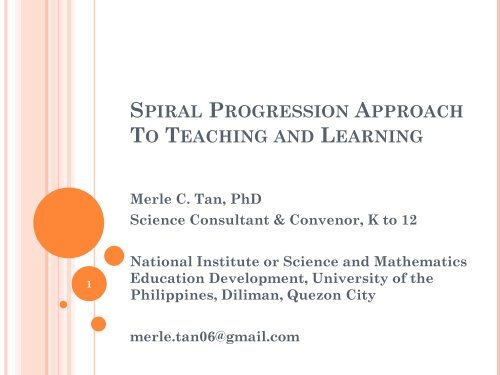

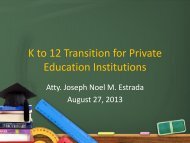
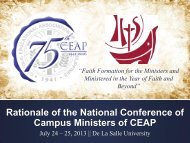
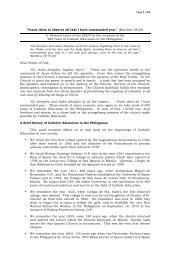
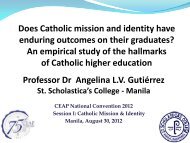

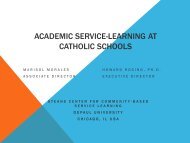

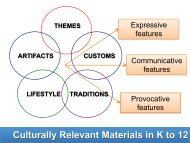
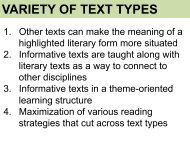
![Harmony Prayer (Silsilah Dialogue Movement) [Compatibility Mode]](https://img.yumpu.com/17302648/1/190x135/harmony-prayer-silsilah-dialogue-movement-compatibility-mode.jpg?quality=85)
